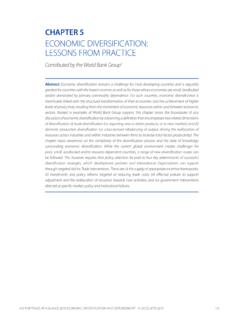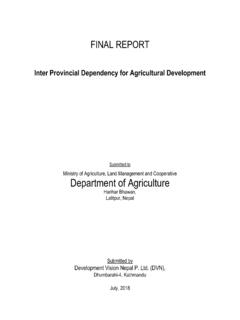Transcription of LAND RESOURCES AND AGRICULTURE
1 Unit IIIUnit IIIUnit IIIUnit IIIUnit IIIC hapter 5 LAND RESOURCESAND AGRICULTUREYou must have observed that the land aroundyou is put to different uses. Some land isoccupied by rivers, some may have trees andon some parts roads and buildings have beenbuilt. Different types of lands are suited todifferent uses. Human beings thus, use landas a resource for production as well as residenceand recreation. Thus, the building of yourschool, roads on which you travel, parks inwhich you play, fields in which crops are grownand the pastures where animals graze representdifferent uses to which land is Use CategoriesLand Use CategoriesLand Use CategoriesLand Use CategoriesLand Use CategoriesLand-use records are maintained by landrevenue department. The land use categoriesadd up to reporting area, which is somewhatdifferent from the geographical area.
2 TheSurvey of India is responsible for measuringgeographical area of administrative units inIndia. Have you ever used a map prepared bySurvey of India? The difference between the twoconcepts are that while the former changessomewhat depending on the estimates of theland revenue records, the latter does not changeand stays fixed as per Survey of Indiameasurements. You may be familiar with landuse categories as they are also included in yourSocial Science textbook of Class land-use categories as maintained inthe Land Revenue Records are as follows :(i)Forests : It is important to note thatarea under actual forest cover isdifferent from area classified as latter is the area which theGovernment has identified anddemarcated for forest growth. The landrevenue records are consistent withthe latter definition. Thus, there maybe an increase in this category withoutany increase in the actual forest cover.
3 (ii)Land put to Non-agricultural Uses :Land under settlements (rural andurban), infrastructure (roads, canals,etc.), industries, shops, etc. areincluded in this category. An expansionin the secondary and tertiary activities2015-16would lead to an increase in thiscategory of land-use.(iii)Barren and Wastelands : The landwhich may be classified as awasteland such as barren hillyterrains, desert lands, ravines, cannot be brought undercultivation with the availabletechnology.(iv)Area under Permanent Pastures andGrazing Lands : Most of this type landis owned by the village Panchayat orthe Government. Only a smallproportion of this land is privatelyowned. The land owned by the villagepanchayat comes under CommonProperty RESOURCES .(v)Area under Miscellaneous TreeCrops and Groves(Not included isNet sown Area) : The land underorchards and fruit trees are includedin this category.
4 Much of this land isprivately owned.(vi)Culturable Waste-Land : Any landwhich is left fallow (uncultivated) formore than five years is included in thiscategory. It can be brought undercultivation after improving it throughreclamation practices.(vii)Current Fallow : This is the landwhich is left without cultivation for oneor less than one agricultural is a cultural practice adoptedfor giving the land rest. The landrecoups the lost fertility through naturalprocesses.(viii)Fallow other than Current Fallow :This is also a cultivable land which isleft uncultivated for more than a yearbut less than five years. If the land isleft uncultivated for more than fiveyears, it would be categorised asculturable wasteland.(ix)Net Area Sown : The physicalextent of land on which crops aresown and harvested is known as netsown Changes in IndiaLand-use Changes in IndiaLand-use Changes in IndiaLand-use Changes in IndiaLand-use Changes in IndiaLand-use in a region, to a large extent, isinfluenced by the nature of economicactivities carried out in that region.
5 However,while economic activities change over time,land, like many other natural RESOURCES , isfixed in terms of its area. At this stage, oneneeds to appreciate three types of changesthat an economy undergoes, which affectland-use.(i)The size of the economy (measuredin terms of value for all the goods andservices produced in the economy)grows over time as a result ofincreasing population, change inincome levels, available technologyand associated factors . As a result, thepressure on land will increase withtime and marginal lands would comeunder use.(ii)Secondly, the composition of theeconomy would undergo a change overtime. In other words, the secondary andthe tertiary sectors usually grow muchfaster than the primary sector, specificallythe agricultural sector. This type ofchange is common in developingcountries like India.
6 This process wouldresult in a gradual shift of land fromagricultural uses to non-agriculturaluses. You would observe that suchchanges are sharp around large urbanareas. The agricultural land is being usedfor building purposes.(iii)Thirdly, though the contribution of theagricultural activities reduces over time,the pressure on land for agriculturalactivities does not decline. The reasonsfor continued pressure on agriculturalland are:(a)In developing countries, theshare of population dependenton AGRICULTURE usually declinesmuch more slowly compared tothe decline in the sector s sharein GDP.(b)The number of people that theagricultural sector has to feed isincreasing day by RESOURCES and AGRICULTURE 412015-1642 India : People and EconomyCompare the change in shares of primary, secondaryand tertiary sectors in GDP between 1960-61 and 1999-2000 with the changes of land-use between 1960-61and 2008-09 using Appendix (vii) Tables 1 and has undergone major changes withinthe economy over the past four or five decades,and this has influenced the land-use changesin the country.
7 These changes between 1960-61 and 2008-09 have been shown in Fig. are two points that you need to rememberbefore you derive some meaning from thisfigure. Firstly, the percentages shown in thefigure have been derived with respect to thereporting area. Secondly, since even thereporting area has been relatively constant overthe years, a decline in one category usuallyleads to an increase in some other categories have undergone increases,while four have registered declines. Share ofarea under forest, area under non-agriculturaluses, current fallow lands and net area sownhave shown an increase. The followingobservations can be made about theseincreases:(i)The rate of increase is the highest in caseof area under non-agricultural uses. Thisis due to the changing structure ofIndian economy, which is increasinglydepending on the contribution fromindustrial and services sectors andexpansion of related infrastructuralfacilities.
8 Also, an expansion of areaunder both urban and rural settlementshas added to the increase. Thus, the areaunder non-agricultural uses isincreasing at the expense of wastelandsand agricultural land.(ii)The increase in the share under forest,as explained before, can be accountedfor by increase in the demarcated areaunder forest rather than an actualincrease in the forest cover in the country.(iii)The increase in the current fallow cannotbe explained from informationpertaining to only two points. The trendof current fallow fluctuates a great dealover years, depending on the variabilityof rainfall and cropping cycles.(iv)The increase in net area sown is a recentphenomenon due to use of culturablewaste land for agricultural which it was registering a slowdecrease. There are indications thatmost of the decline had occurred due tothe increases in area under non-agricultural use.
9 (Note : the expansionof building activity on agricultural landin your village and city).Note : Categories (iv) and (v) of Section I have been clubbed together in the RESOURCES and AGRICULTURE 43 The four categories that have registered adecline are barren and wasteland, culturablewasteland, area under pastures and tree cropsand fallow following explanations can be givenfor the declining trends:(i)As the pressure on land increased, bothfrom the agricultural and non-agricultural sectors, the wastelands andculturable wastelands have witnesseddecline over time.(ii)The decline in land under pastures andgrazing lands can be explained bypressure from agricultural land. Illegalencroachment due to expansion ofcultivation on common pasture lands islargely responsible for this is the difference between actual increase andrate of increase?
10 Work out the actual increase andrate of increases for all the land use categories between1960-61 and 2008-09 from the data given in the Appendix(vii) (Table 1). Explain the for TeacherFor calculating actual increase, the difference of theland-use categories should be worked out over the deriving the rate of increase, simple growth rate (difference of values between the two time points of terminal year minus base year / base year or1960-61 value) should be used, sown Area in 2008-09 Net sown A rea in 1960-61 Net sown A rea in 1960-61- Common PrCommon PrCommon PrCommon PrCommon Properoperoperoperoperty Rty Rty Rty Rty Resouresouresouresouresourcescescescesce sLand, according to its ownership can broadlybe classified under two broad heads privateland and common property RESOURCES (CPRs).While the former is owned by an individual or agroup of individuals, the latter is owned by thestate meant for the use of the community.
















